| August 29, 2007 |  |
our time will build eternity |
| Previous Issues | Aug 28 | Aug 27 | Aug 24 | Aug 23 | Aug 22 |
Airplane Monitors Great Lakes Algae Cleveland OH (SPX) Aug 29, 2007
Cleveland OH (SPX) Aug 29, 2007A rare bird has been flying over the Great Lakes recently, and it isn't migrating or searching for prey. This hawkeyed species is a Learjet aircraft outfitted with an advanced imaging system. Engineers at NASA's Glenn Research Center in Cleveland modified the plane to help the National Oceanic and Atmospheric Administration (NOAA) monitor algae in western Lake Erie and Lake Huron's Saginaw Bay. ... more Recon Orbiter Camera Issue Resolved As 3000th Image Comes Down From Mars  Pasadena CA (JPL) Aug 24, 2007
Pasadena CA (JPL) Aug 24, 2007Diagnostic tests and months of stable, successful operation have resolved concerns raised early this year about long-term prospects for the powerful telescopic camera on NASA's Mars Reconnaissance Orbiter. The High Resolution Imaging Science Experiment (HiRISE) camera on the orbiter has now taken more than 3,000 images of Mars, resolving features as small as a desk in targeted areas covering ... more Mars Rovers Get About As Spirit Clips Viking 2 For Ground Duty  Pasadena CA (JPL) Aug 24, 2007
Pasadena CA (JPL) Aug 24, 2007After six weeks of hunkering down during raging dust storms that limited solar power, both of NASA's Mars Exploration Rovers, Spirit and Opportunity, have resumed driving. Opportunity advanced 13.38 meters (44 feet) toward the edge of Victoria Crater on Aug. 21. Mission controllers were taking advantage of gradual clearing of dust from the sky while also taking precautions against buildup of ... more Brightening Skies Bolster Opportunity For MER-B To Survive 2007 Dust Season  Pasadena CA (SPX) Aug 27, 2007
Pasadena CA (SPX) Aug 27, 2007Opportunity is healthy and remains perched near the rim of "Victoria Crater." The rover was on a low-power schedule that alternated between a 3-sol plan and a 4-sol plan. Tau (atmospheric opacity) has begun to stabilize this week at around 3.7, resulting in solar array energy between 230-240 watt hours. Therefore in the upcoming week, the team will return to nominal planning. ... more Drawing A Living On Lunar  Hampton VA (SPX) Aug 24, 2007
Hampton VA (SPX) Aug 24, 2007A new NASA contest encourages university art and design students to partner with science and engineering departments to create art representative of living and working on the moon. The goal is for students in the arts, science and engineering to collaboratively engage in NASA's mission to return humans to the moon by 2020, and eventually journey on to Mars and other destinations in the solar system ... more |
shuttle
 shuttle 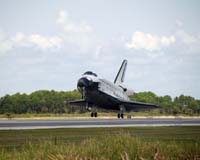 mars-phoenix 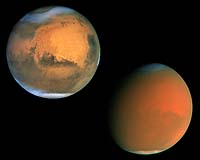 |
 Pasadena CA (JPL) Aug 22, 2007
Pasadena CA (JPL) Aug 22, 2007Even though the Martian sky above Gusev Crater continued to clear, solar power levels on NASA's Spirit rover remained fairly constant as dust settling from the atmosphere accumulated on top of the solar panels. Activities remained restricted. Measurements of atmospheric opacity, known as Tau, dropped from 3.6 on Martian day, or sol, 1283 (Aug. 12, 2007) to 3.3 on sol 1286 (Aug. 16, 2007) ... more Mars-500 Experiment Could Be Extended To 700 Days  Zhukovsky, Russia (RIA Novosti) Aug 23, 2007
Zhukovsky, Russia (RIA Novosti) Aug 23, 2007A simulated Mars mission, expected to be launched in Russia later this year, could be extended from 500 to 700 days, the head of the Russian Space Agency said Wednesday. Speaking at the MAKS-2007 air show outside Moscow, Anatoly Perminov said: "There are proposals to extend the Mars-500 experiment at the Russian Institute of Medical and Biological Studies...probably to 700 days." ... more Gloomy Skies Show Signs of Clearing  Pasadena CA (JPL) Aug 17, 2007
Pasadena CA (JPL) Aug 17, 2007Spirit is healthy as the amount of dust hoisted into the atmosphere by recent wind storms has leveled off and solar energy levels have held steady at about 280 to 300 watt-hours of energy (100 watt-hours is the amount of energy needed to light a 100-watt bulb for one hour). Since the rover's 1,271st Martian day, or sol, of exploration (July 31, 2007), atmospheric opacity, a measurement known as ... more Student Joins AMASE Expedition In Svalbard  Svalbard, Denmark (SPX) Aug 20, 2007
Svalbard, Denmark (SPX) Aug 20, 2007For two weeks, an international crew of scientists and engineers are field-testing instruments for future Mars missions. Thea Falkenberg, winner of a student contest to join the AMASE expedition, reports back on her experiences through a daily blog. The Arctic Mars Analog Svalbard Expedition (AMASE) takes advantage of similarities between the conditions on Mars and those at Svalbard in order to ... more |
nuclearspace
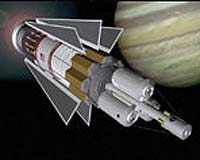 rocketscience  stellar-chemistry  |
 Paris, France (ESF) Aug 14, 2007
Paris, France (ESF) Aug 14, 2007Earth's surface is a very active place; its plates are forever jiggling around, rearranging themselves into new configurations. Continents collide and mountains arise, oceans slide beneath continents and volcanoes spew. As far as we know Earth's restless surface is unique to the planets in our solar system. So what is it that keeps Earth's plates oiled and on the move? Scientists think tha ... more Phoenix Adjusts Course Successfully For Journey To Mars  Pasadena (SPX) Aug 12, 2007
Pasadena (SPX) Aug 12, 2007NASA has commanded the Phoenix Mars Lander to make the first and largest of six course corrections planned during the spacecraft's flight from Earth to Mars. Phoenix left Earth Aug. 4, bound for a challenging touchdown on May 25, 2008, at a site farther north than any previous Mars landing. It will robotically dig to underground ice and run laboratory tests assessing whether the site could ever ... more What Makes Mars Magnetic  Paris, France (ESF) Aug 12, 2007
Paris, France (ESF) Aug 12, 2007Earth's surface is a very active place; its plates are forever jiggling around, rearranging themselves into new configurations. Continents collide and mountains arise, oceans slide beneath continents and volcanoes spew. As far as we know Earth's restless surface is unique to the planets in our solar system. So what is it that keeps Earth's plates oiled and on the move? Scientists think tha ... more Helping Phoenix Land  Tucson AZ (SPX) Aug 10, 2007
Tucson AZ (SPX) Aug 10, 2007The Phoenix Mars Lander launched on Saturday, August 4, beginning a journey to never-explored regions of the Red Planet to search for frozen water beneath the Martian surface. What it discovers will help scientists determine if Mars could support life. NASA's Jet Propulsion Laboratory (JPL) in Pasadena, Calif. and Langley Research Center in Hampton, Va. are working together with the University o ... more
|
mars-mers
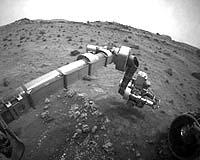 mars-phoenix  early-earth 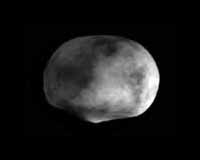 |
| Previous Issues | Aug 28 | Aug 27 | Aug 24 | Aug 23 | Aug 22 |
| The contents herein, unless otherwise known to be public domain, are Copyright 1995-2007 - SpaceDaily. AFP and UPI Wire Stories are copyright Agence France-Presse and United Press International. ESA Portal Reports are copyright European Space Agency. All NASA sourced material is public domain. Additional copyrights may apply in whole or part to other bona fide parties. Advertising does not imply endorsement, agreement or approval of any opinions, statements or information provided by SpaceDaily on any web page published or hosted by SpaceDaily. Privacy statement |